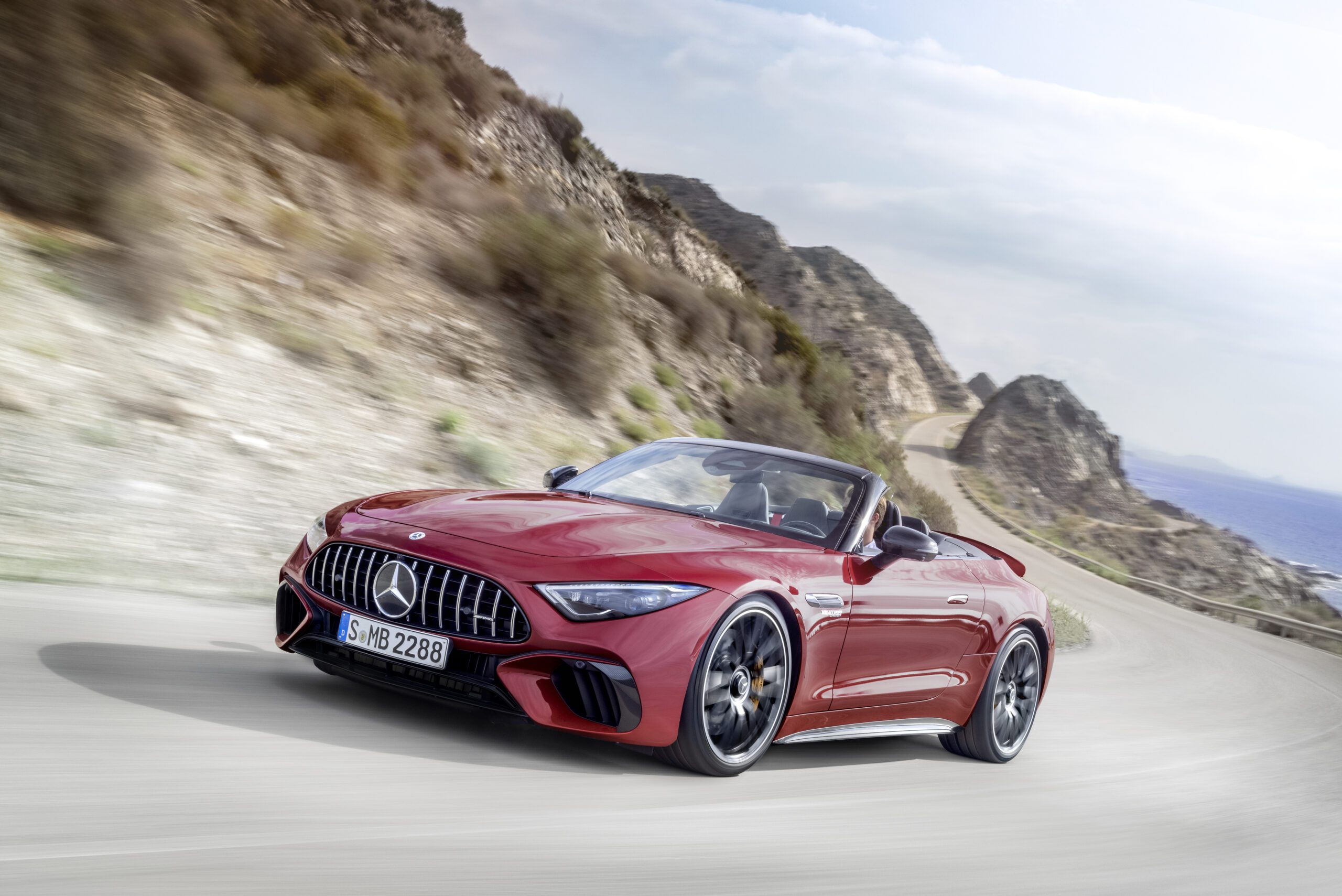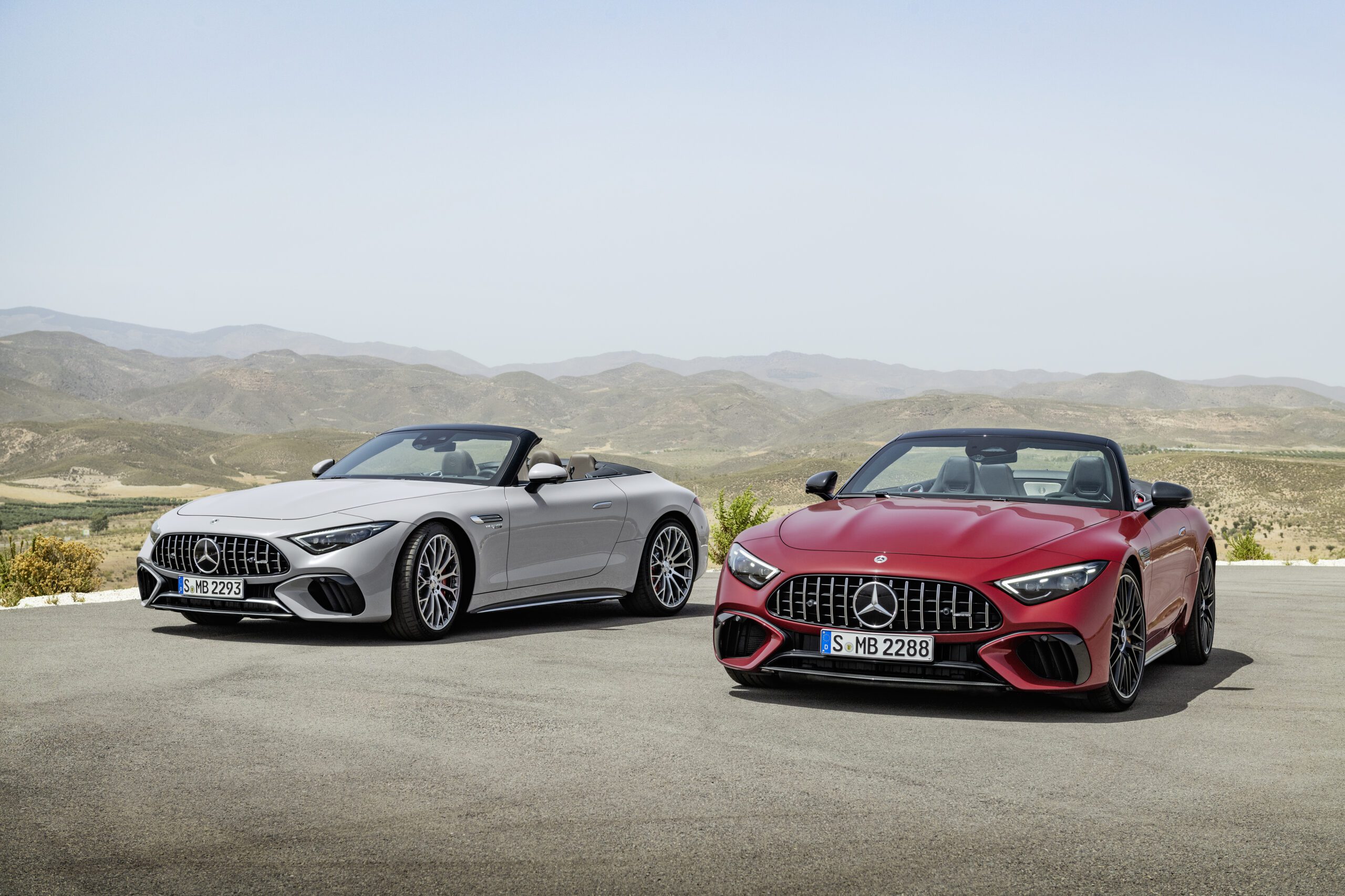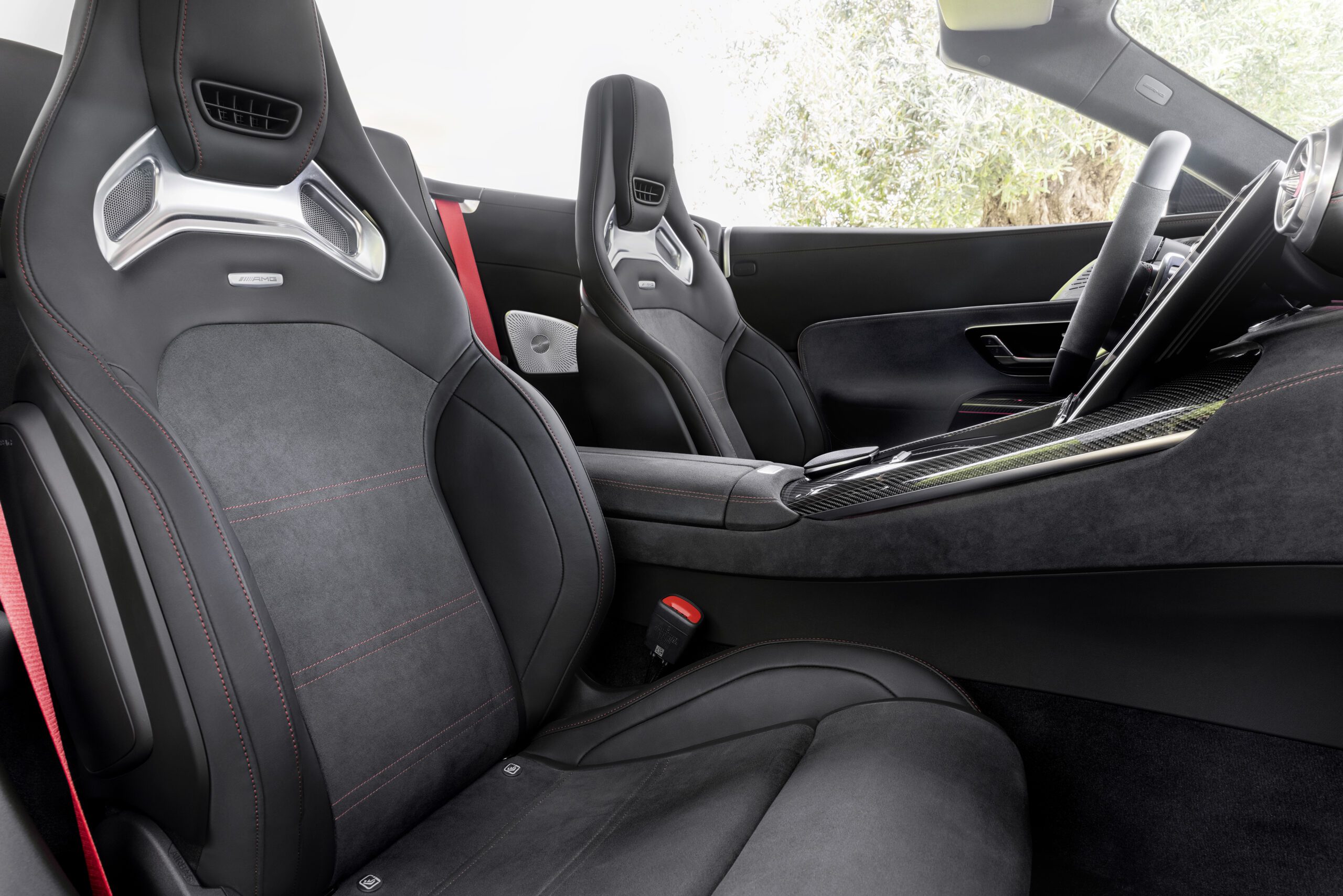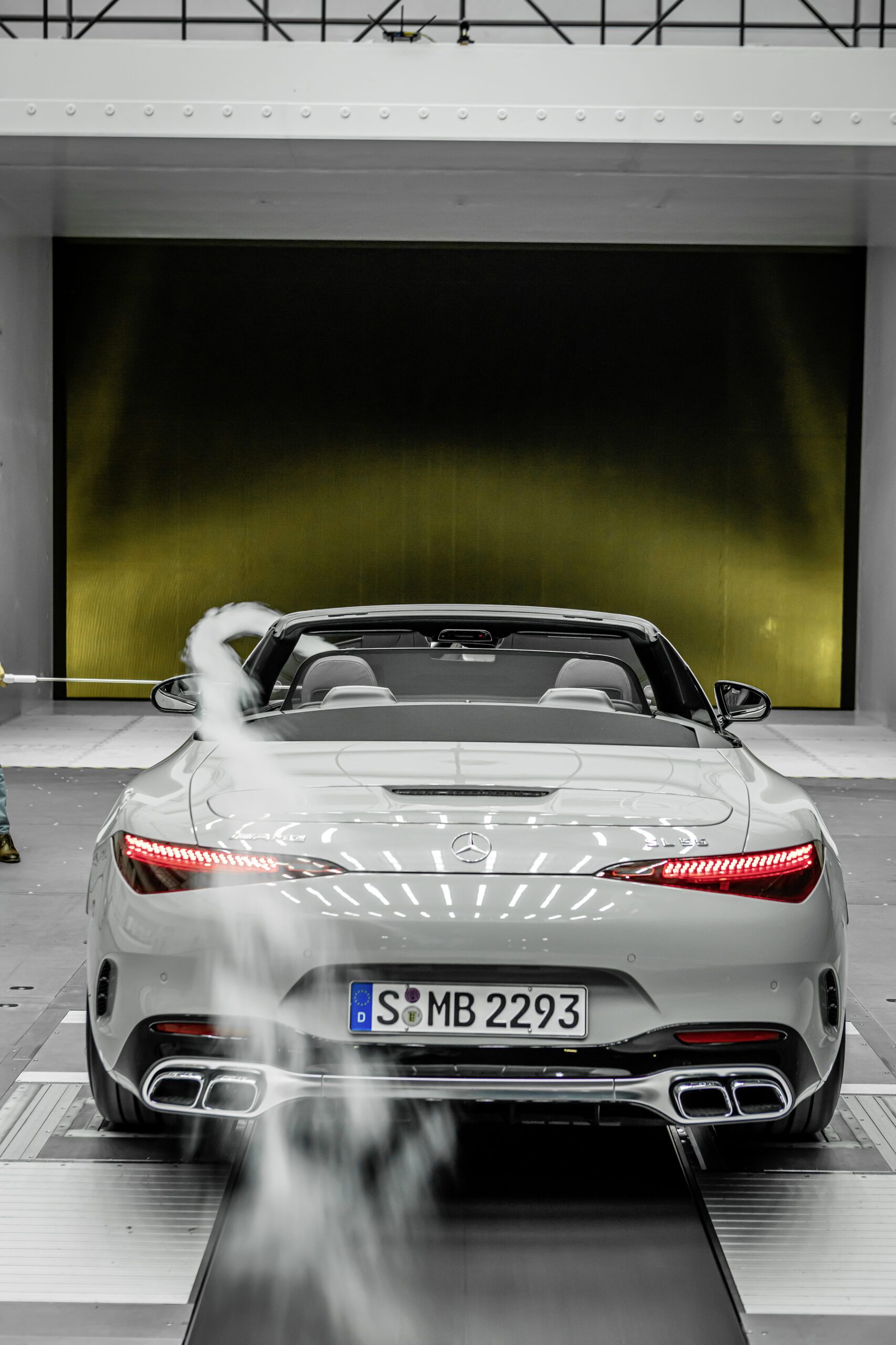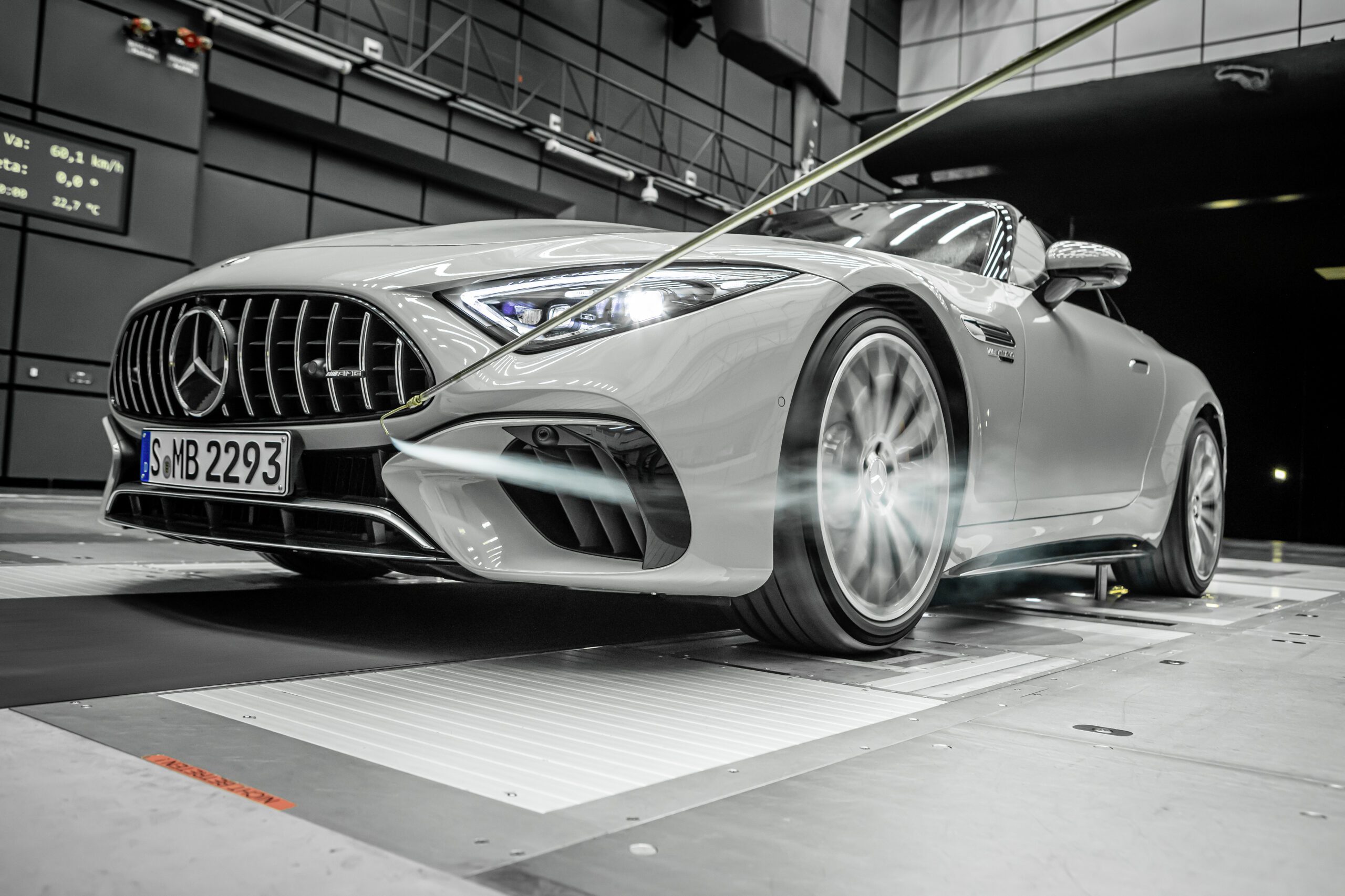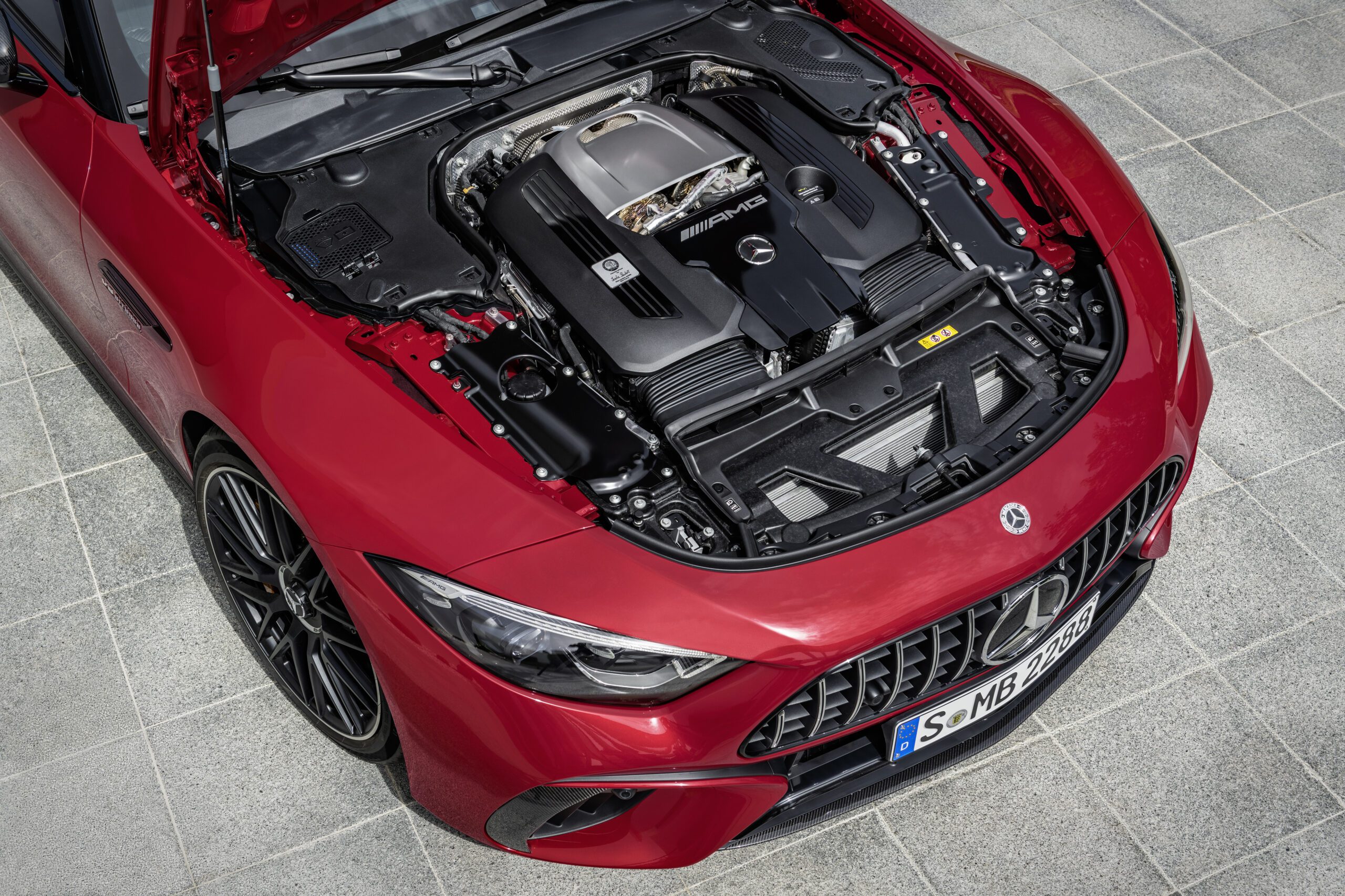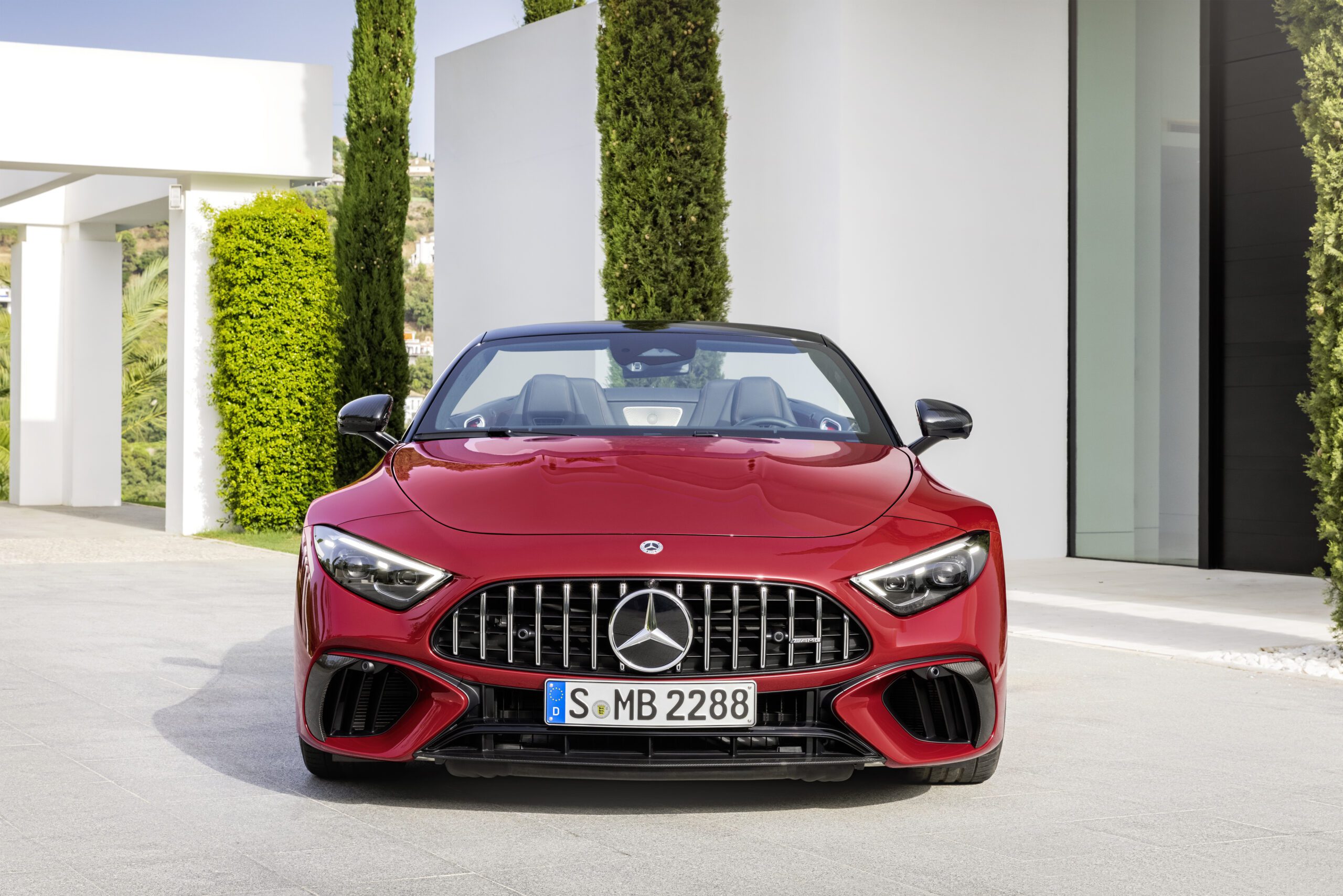The newest edition of an icon, the Mercedes-AMG SL goes back to basic with a classic soft top and sporty character. The 2+2-seater is great for everyday use and for the first time, they created an all-wheel drive.
The SL is equipped with high-tech components like the AMG ACTIVE RIDE CONTROL suspension with active anti-roll stabilization and rear-axle steering. To really maximize the sporty profile, Mercedes-AMG added as standard the DIGITAL LIGHT with projection function. The AMG ceramic high-performance composite brake system is being offered as an option.
Matched with the AMG 4.0-liter V8 biturbo engine, the combination gives unparalleled driving experience. Mercedes-AMG has built their reputation as a Performance Luxury manufacturer, and the company developed the SL in Affalterbach completely independently.
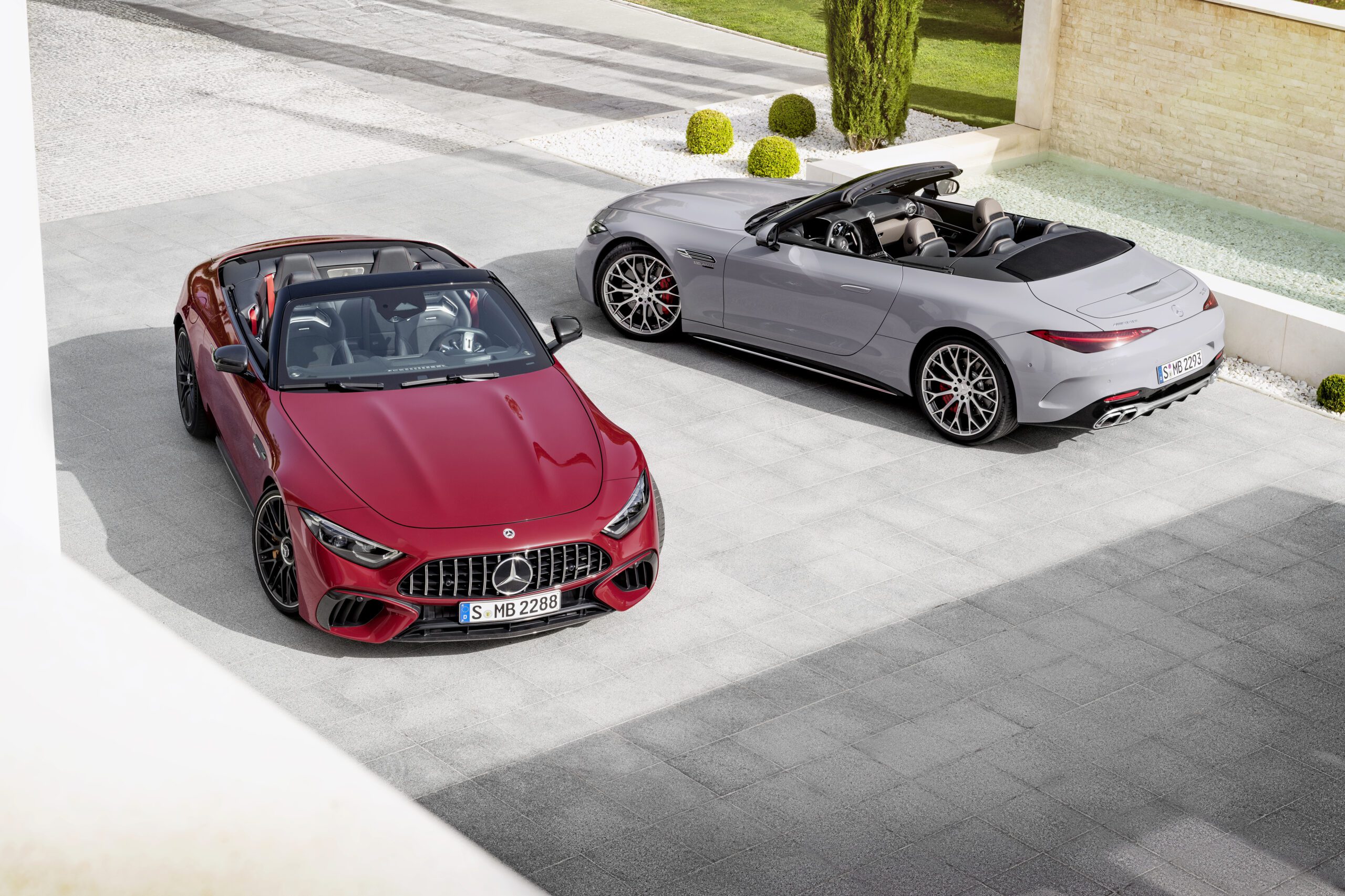

Kicking off the market launch are two models with AMG V8 engines.
It has almost been 70 years when a sports car launched in Stuttgart became an instant legend. From that first success, Mercedes-Benz envisioned expanding their potential through motor racing successes. This vision produced the first SL – a road-going racing sports car.
The 300 SL – with an internal designation of W 194 – made its debut in 1952, it recorded victory after victory in various racetracks all over the world. In its first year alone, it achieved an impressive one-two victory in the legendary 24 Hours of Le Mans. If that is not enough, it also recorded four first place finishes at the Nürburgring Grand Jubilee Prize for sports cars. The successes of the 300 SL made it a legend.
In 1954, the highly successful racing car was followed by the production sports car 300 SL – internally dubbed as the W 198. Due to its unusual doors, it was given the nickname “Gullwing”. Its influence is so strong, that in 1999, a jury of motoring journalists picked the Gullwing as the “Sports Car of the Century”.
Other notable cars in its model history include the “Pagoda” called W 113 and was produced from 1963-1971, the evergreen R 107 had a really long production time from its release in 1971, with the last produced in 1989. The R 129 came next and due to its striking wedge shape, was considered to be an automotive structure.
To this day, the SL is considered to be one of the few real automotive icons in the world.
The development of the SL spans for decades with car enthusiasts following its evolution from full-blooded racing cars to open-top luxury sports car. Now, the new Mercedes-AMG SL creates another milestone. It seamlessly brought together the sportiness of the original SL with the luxury of technological advancements that embodies the modern Mercedes models.
“The SL is an icon: For almost 70 years, the distinctive sports car has delighted Mercedes customers of every generation around the world. With the rebirth of the roadster from Mercedes-AMG, the new SL more than ever remains the symbol of this timeless fascination”, shared Britta Seeger, Member of the Board of Management of Daimler AG and Mercedes-Benz AG, responsible for Mercedes-Benz Cars Marketing and Sales.
Mercedes-AMG GmbH Chairman of the Board of Management Philipp Schiemer added, “The new SL combines the sporty genes of the original SL with the driving performance typical of AMG. At the same time, it offers luxury and comfort at the absolute top level. This combination is unique in the sports car segment and is also reflected in the interior – where the highest levels of comfort and quality meet the right helping of sportiness. The high-quality combination of analogue world and state-of-the-art digital equipment makes it clear that the new SL is the rebirth of an icon for the modern era”.
Daimler Group Chief of Design Officer Gorden Wagener said, “With the new SL, we have created a repositioning of the iconic SL design. The expressively modelled exterior conveys a light and purist impression and brings sensual beauty and extravagant design into perfect harmony”.
“We at Mercedes-AMG consider it a great honour to have had the privilege to develop the new edition of this sports car icon. When we were tasked with the overall development of the new SL, we were able to start from scratch without building on an existing structure. We are proud of the result, which once again demonstrates the high level of engineering expertise in Affalterbach. The new 2+2 concept combines agile driving dynamics with a high level of comfort and unrestricted suitability for everyday use”, says Jochen Hermann, Chief Technical Officer of Mercedes-AMG GmbH.
The new Mercedes-AMG SL really raises the bar in the luxury sports car segment with its state-of-the-art technology, outstanding driving characteristics, and exquisite design.
The exterior design of the Mercedes-AMG SL perfectly brings together the sensual purity of modern Mercedes-Benz design with the typical sportiness of AMG, with characteristic details. The two power bulges on the bonnet of the new SL is one of the features that is clearly inspired by the first SL generation. The interaction of the light and shadow on the new SL gives an overall light and low appearance, making it clear at just the first glance that the new SL has gone back to basics with its sporty roots.
Balanced Exterior Design with Sporty Genes
The body design of the new SL has kept some of its characteristic features like the short overhands, long wheelbase, long bonnet, the passenger compartment set back with a strongly raked windscreen, as well as the powerful rear end. Those combinations resulted in a typical SL in terms of proportions. Matched with the large alloy wheels and voluminously sculpted wheel arches, it resulted into a roadster that looks both powerful and dynamic. When the seamlessly integrated soft top is closed, it emphasizes the purist, sporty appearance.
The AMG-specific radiator grille highlights the effect of width of the front and its 14 vertical slats, reminiscent of original SL model: the legendary 1952 300 SL racing sports car. The new SL also has other unique design elements like the thin, sharply outlined DIGITAL LIGHT LED headlamps as well as the really thin LED rear lamps.
Interior design: ‘Hyperanalogue” cockpit and Performance Luxury
The interior of the new Mercedes-AMG SL brings forward the tradition of the first 300 SL Roadster into the modern era. The new edition is the perfect combination of luxury with sporting virtues. To provide the highest levels of comfort, the new SL used the best materials and expert workmanship. The cockpit was designed with the driver as the focus, even to the adjustable central display in the center console.
The new interior space concept with 2+2 seats provides more room and functionality. The rear seats make the SL practical for daily use and gives more space for people up to 1.5 meters tall.
The 300 SL Roadster’s minimalist interior using the highest quality materials are what inspired the designers in conceptualizing the interior of the new SL. This resulted in an exciting combination of analogue technology with the digital world, called ‘hyperanalogue”. This is seen on the fully digital instrument cluster which is integrated into a three-dimensional visor. The standard MBUX infotainment system also gives a choice between several different modes and specific display styles.
One of the many notable features in the interior of the new SL is the sculptural seat design that comes in the standard, electrically adjustable AMG sports seats. The backrest integrates the head restraints, emphasizing the sporty character of the car. The AIRSCARF comes as standard. Air outlets in the head restraints allow warm air to flow into the passenger compartment and wraps around the head and neck area of the driver as well as the front passenger like a scarf. The interior has perfect ergonomics. Available as an option are the AMG Performance seats.
The new SL comes with the latest generation Mercedes-Benz User Experience (MBUX) and it has the capacity to learn and is intuitive to use. It has numerous functional contents as well as the operating structure used on the second-generation MBUX system which was first seen in the new Mercedes-Benz S-Class. The SL comes with AMG-specific content that can be seen in the five display styles. The sporty character of the car is emphasized in its exclusive menu items like the “AMG Performance” and the “AMG TRACK PACE”.
Body Shell
Mercedes-AMG developed a completely new vehicle architecture for the 2+2-seater 2021 SL. The chassis was made from a lightweight composite aluminum structure that is made up of an aluminum space frame with a self-supporting structure. The design ensures maximum rigidity that provides the highest comfort, precise driving dynamics, optimal packaging, and sporty body proportions. Like the first SL back in 1952, the new body shell was designed literally on a blank sheet of paper. No component in the new SL came from its predecessors nor from any other model like the AMG GT Roadster.
The body shell architecture aims to provide the driving performance that is expected of AMG focusing on the lateral and longitudinal dynamics while also delivering on the high standards of comfort and safety. The intelligent material mix in the new SL allows the highest possible rigidity at a low weight. Material cross-sections are optimized, and the sophisticated component shapes allows for the comprehensive comfort and safety features as well as the soft top to be added. A mix of materials are used like aluminum, fiber composites, magnesium, and steel to create different parts like the windscreen frame. It serves as a roll-over protection along with the roll bar system at the back of the rear seats which can immediately be extended when needed.
The torsional rigidity of the body shell structure is improved by 18 percent compared to the previous model series. The transverse rigidity is 50 percent better than the already impressive value of the AMG GT Roadster, while the longitudinal rigidity is 40 percent higher. The plain body shell weights around 270 kilograms. Matched with a low center of gravity, the lightweight construction guarantees outstanding driving dynamics.
Active aerodynamics gives perfect balance and high efficiency
High aerodynamic efficiency was one of the key development focuses of the new SL. They specifically worked on the balance between low drag and reduced lift. This is where the luxurious roadster is greatly benefited from the wide-ranging motorsport expertise of Mercedes-AMG.
Extensive active aerodynamic elements can be seen on the front and rear with all the streamlining elements integrated perfectly with the exterior design. Additional detailed measures lowered the drag coefficient to Cd 0.31 which is an excellent figure for an open-top sports car.
The aerodynamics of the SL had to deal with the complex requirements of drag, cooling, handling stability, and wind noise. The driving characteristics and vehicle character of the new SL are constant whether the top is down or up. The even aerobalance assists in defusing critical driving situations like a sudden evasive maneuver while driving at high speed.
AIRPANEL air control system
The AIRPANEL is an active air control system that is a technical highlight in the aero development of the new SL. The car is equipped with two AIRPANELs. The first piece is placed behind the lower air intake in the front apron, and it operates with vertical louvres. The second piece is hidden behind the upper air intake and has horizontal louvres. All louvres are normally closed. This position minimizes drag and leads the air specifically towards the underbody, further lowering front lift. When certain temperatures on predefined components are reached and there is a need for cooling air, the louvres open. The second system only opens from 180 kph, to let maximum cooling air to flow to the heat exchangers.
The retractable rear spoiler that is flawlessly integrated into the lid is another active component. Its position is changed depending on the driving status. To do this, the control software takes into account a few things: the driving speed, longitudinal and lateral acceleration, and the steering speed. The spoiler has five different angular positions that it can use from 80 kph to either reduce drag or to optimize handling stability.
Hidden in the underbody in front of the engine is the optional active aerodynamic element that also helps in improving handling. The carbon profile roughly weights two kilograms, and it reacts to the setting of the AMG driving modes. At the speed of 80 kph, it automatically extends downwards by roughly 40 millimeters, activating the AMG driving modes. It creates what is called the Venturi effect, which reduces the front-axle lift as it sucks the car more to the road surface. The driver feels the change in the steering, allowing for more precise and stable steering in bends and tracks.
The new SL has a variety of aerodynamically optimized alloy wheels that comes in 19, 20, or 21 inches in diameter, minimizing drag by having less turbulence. The 20-inch wheels with plastic aero rings are particularly sophisticated, and also save weight.
The Soft Top
With the new SL promising to be sportier than its immediate predecessors, it is not a surprise that it was given an electric soft top instead of the metal vario roof that was previously used. It took away a huge 21 kilograms in weight, while also giving the new SL a lower center of gravity, giving it an overall positive effect on handling and driving dynamics. The space- and weight-saving Z-fold, the conventional soft-top compartment cover can be removed. The front roof cap makes sure that the final position of the open soft top is flush with the surface.
The developers were also tasked to create the new SL to be suitable for everyday use and to provide great noise comfort. They created a three-layer design which had a tightly stretched outer shell, precisely crafted roof liner, and in between the two is the acoustic mat made from high-quality 450 g/m² material.
It takes only about 15 seconds to open and close the soft top, and it can even be done even at speeds of 60 kph. A switch panel in the center console operates the soft top. It can also be done through the multimedia touchscreen wherein it’ll show an animation of the car to show how the process is progressing.
Engine, transmission, and all-wheel drive
At market launch, the new SL will have two output levels with the AMG 4.0-liter V8 biturbo engine. The engines are assembled at Affalterbach, purely by hand adhering to the company’s “One Man, One Engine” principle.
The SL 63 4MATIC+ (combined fuel consumption is 12.7-11.8 l/100 km, combined CO2 emissions is 288-268 g/km) the engine produces 430 kW (585 hp) with a maximum torque of 800 Nm on a wide rev range of 2500 to 4500 rpm. It only takes 3.6 seconds to accelerate from 0 to 100 kph. It has a top speed of 315 kph.
The SL 55 4MATIC+ (combined fuel consumption is 12.7-11.8 l/100 km, combined CO2 emissions is 288-268 g/km) the V8 engine can produce 350 kW (476 hp) with a maximum torque of 700 Nm. It takes 3.9 seconds for the car to accelerate from 0 to 100 kph. It has a top speed of 295 kph.
For the new SL, the engine was equipped with a new oil pan while they repositioned the active crankcase ventilation and the intercoolers. To have a more effective gas exchange, the intake and exhaust ducts were optimized, while they made the exhaust gas routing for the catalytic converter box and petrol particulate filter larger. The increased output of the SL 63 4MATIC+ was achieved by the developers mainly through the higher boost pressure, modified engine software, and increased air flow.
In summary, the eight-cylinder engine thrills with its excellent power delivery and powerful acceleration in all engine speed ranges along with maximum efficiency for low consumption and emission values.


Performance Hybrid in Development
Mercedes-AMG will also eventually be offering the SL as a powerful Performance hybrid drive. The AMG E PERFORMANCE drive strategy is guided by its principle of providing an electrified powertrain that improves driving dynamics and efficiency.
Transmission
The AMG SPEEDSHIFT MCT 9G transmission brings together a satisfying gearshift experience with short shift times that is specially developed for the new SL. The former torque converter is replaced by a wet start-off clutch. It not only reduces the weight, but it also optimizes the response of the accelerator pedal commands due to its lower inertia especially during spurts and load changes.


Fully variable AMG Performance 4MATIC+ all-wheel drive
In its almost 70-year history, this is the first time that the SL will be available with an all-wheel drive system. As standard, the two V8 models will have the AMG Performance MATIC+ all-wheel drive technology. The intelligent system brings together the advantages of different drive concepts: the fully variable torque distribution to the front and rear axles guarantees optimal traction until its physical limit. The driver can depend on high handling stability and safety in all conditions.
Suspension and Brakes
The newly developed AMG RIDE CONTROL steel suspension with very capable aluminum shock absorbers and lightweight coil springs will come as standard on the SL 55 4MATIC+.
As another first, the series-production Mercedes-AMG will also be equipped with a multi-link front axle with five links arranged completely within the rim, greatly improving the kinematics. A 5-link design also controls the wheels at the rear axle.
Making its debut in the SL 63 4MATIC+ is the innovative AMG ACTIVE RIDE CONTROL suspension with active, hydraulic anti-roll stabilization. Its biggest innovation is the introduction of Active hydraulic elements that replaces the typical mechanical anti-roll bars and compensate for rolling movements of the new SL in milliseconds. The system also provides optimal steering and load-change behavior with the AMG-typical driving characteristics in terms of precision, dynamics, and feedback for the driver. It also improves on ride comfort with driving in straight lines and over bumps.
The new AMG high-performance composite braking system also ensures great deceleration values and complete control. It responds excellently in short braking distances while also providing high stability- even in extreme stress. The new composite brake discs are more compact and lighter which makes it even better for brake cooling. The directional perforation is another innovation, aside from improved heat dissipation and lighter weight, it also gives faster response in wet conditions and has improved pad cleaning after braking.
Active rear-axle steering
Another first in the new SL is the active rear-axle steering that comes as standard. While steering, the rear wheels changes direction from the front wheels depending on the speed. They steer in the opposite direction for speeds up to 100 kph or they’ll steer in the same direction for speeds faster than 100 kph. This allows the system to provide agile and stable handling, characteristics that are contrasting without the rear-axle steering.
Other improvements include better vehicle control at the limits, while also lowering steering effort due to the more direct front-wheel steering ratio.
Six driving modes and AMG DYNAMICS
The AMG DYNAMIC SELECT provides six driving modes: Individual, Comfort, Slippery, Sport, Sport +, and RACE. The RACE driving mode comes as standard in the SL 63 4MATIC+, while the AMG DYNAMIC PLUS can be added as an option for the SL 55 4MATIC+. The six modes give a variety of vehicle characteristics from comfortable to dynamic.
Each driving mode provides a different driving experience tailored specifically for different driving conditions. The SL models also feature the AMG DYNAMICS as a feature of the AMG DYNAMIC SELECT driving modes. The integrated vehicle dynamics control broadens the stabilizing functions of the ESP® with the agility-enhancing intervention in the steering characteristics, all-wheel control, and more ESP® functions. When cornering at speeds, the inner rear wheels get a brief braking intervention through a defined yawing motion around the vertical axis for responsive and precise entry into the bend. The spectrum ranges from highly dynamic to extremely stable.
SL range of equipment
The new SL offers a wide variety of equipment details and options for individualization that can accommodate a variety of customer preferences from the luxurious-elegant to the sporty-dynamic. They offer twelve paint color options including two exclusive SL paints, the Hyper Blue metallic and the MANUFAKTUR Monza Grey magno. It has three roof color variants, and a lot of new wheel designs that make the choice a whole new exciting experience.
There are three exterior design packages on offer to fit better with the customer preference from the more elegant to the more dynamic.
As a standard, the SL 55 4MATIC+ will have a 19-inch AMG multi-spoke alloy wheels, but it can also come in silver or matt black as an option. The SL 63 4MATIC+ has a 20-inch AMG 5-twin-spoke alloy wheels. There are nine different variants of wheels to choose from including two aerodynamically optimized 20-inch options in 5-twin-spoke or multi-spoke design. There are also the 21-inch AMG forged wheels in a 5-twin-spoke design and a 21-inch AMG alloy wheels in a 10-spoke design, both will be offered in two color variants.
Driving assistance systems and MBUX
The new roadster is equipped with a driving assistance system that can observe the traffic and its surroundings using the numerous sensors, radars, and cameras. The intelligent helpers can intervene at lightning speed if necessary. As seen in the current Mercedes C-Class and S-Class generations, a lot of new or enhanced systems help support the driver in everyday situations like distance control, assistance for speed adaptation, steering and lane changes.
The assistance systems have the capability to respond to impending collisions when the situation demands. The instrument cluster has a new display concept that visualizes how the system functions.
The new assistance display in the instrument cluster is transparent and comprehensive in showing how the driving assistance systems work in a full-screen view. The instrument cluster shows the driver their own car, the lanes, lane markings, and other things on the road like other cars, trucks, and two-wheelers in an abstract 3D way. The system status and assistant operations are shown in this depiction of the surroundings. The new animated assistance display uses a 3D scene generated in real time. The dynamic, high-quality render makes the driving assistance systems operation transparent as an augmented reality experience.
Connectivity Services
The Mercedes-Benz User Experience (MBUX) infotainment system provides extensive intuitive operating options and a lot of digital services from Mercedes me connect. Its features include the intuitive operating concept through touchscreen or touch control buttons on the steering wheel, hands-free system via Bluetooth connection, smartphone integration of Apple CarPlay and Android Auto, and digital radio (DAB and DAB+).
Customers already have access to connectivity services like the Live Traffic Information, but the Mercedes me connects helps the SL become more intelligent overall. Additional functions can be used before, during, and after the drive.
All that is needed is to have the roadster linked to a Mercedes me account in the Mercedes me portal and accept the terms of use. Live Traffic Information and Car-to-X communication helps the customer navigate the roads with real-time traffic data. This helps the driver efficiently avoid traffic jams to save valuable time. Car-to-X communication allows connected vehicles to exchange information about traffic events.
Technical data1
Mercedes-AMG SL 63 4MATIC+
| Engine | |||
| Number of cylinders/arrangement | – | 8/V | |
| Displacement | cc | 3982 | |
| Rated output | kW/hp | 430/585 | |
| at engine speed | rpm | 5500-6500 | |
| Rated torque | Nm | 800 | |
| at engine speed | rpm | 2500-5000 | |
| Compression ratio | – | 8.6 | |
| Mixture formation | – | Microprocessor-controlled petrol injection, twin turbocharging | |
| Power transmission | |||
| Drive system layout | – | Fully variable AMG Performance 4MATIC+ all-wheel drive | |
| Transmission | – | AMG SPEEDSHIFT MCT 9G (automatic transmission with wet multi-disc start-off clutch) | |
| Gear ratios | |||
| 1st/2nd/3rd/4th/5th/6th/7th/8th/9th gear | – | 5.35/3.24/2.25/1.64/1.21/1.00/0.87/0.72/0.60 | |
| Reverse | – | 4.80 | |
| Suspension | |||
| Front axle | AMG ACTIVE RIDE CONTROL suspension with semi-active anti-roll stabilisation, aluminium double wishbones, anti-dive control, coil springs and adaptive adjustable damping | ||
| Rear axle | AMG ACTIVE RIDE CONTROL suspension with semi-active anti-roll stabilisation, aluminium double wishbones, anti-dive control, coil springs and adaptive adjustable damping | ||
| Brake system | Hydraulic dual-circuit brake system; front 390 mm composite brake discs, vented and perforated, 6-piston aluminium fixed calliper; rear 360 mm composite brake discs, vented and perforated, 1-piston aluminium floating calliper; electric parking brake, ABS, Brake Assist, 3-stage ESP® | ||
| Steering | Electromechanical speed-sensitive power steering with rack and pinion, variable steering ratio (12.8:1 at dead centre) and variable power assistance | ||
| Wheels | front: 9.5 J x 20 H2; rear: 11 J x 20 H2 | ||
| Tyres | front: 265/40 ZR 20; rear: 295/35 ZR 20 | ||
| Dimensions and weights | |||
| Wheelbase | mm | 2700 | |
| Front/rear track | mm | 1660/1625 | |
| Length/height/width | mm | 4705/1353/1915 | |
| Turning circle | m | 12.84 | |
| Boot capacity | l | 213-240 | |
| Kerb weight acc. to EC | kg | 1970 | |
| Payload | kg | 320 | |
| Tank capacity/of which reserve | l | 70/10 | |
| Performance, consumption, emissions | |||
| Acceleration 0-100 km/h | sec. | 3.6 | |
| Maximum speed | km/h | 315 | |
| Combined fuel consumption, WLTP | l/100 km | 12.7-11.8 | |
| Combined CO2 emissions, WLTP | g/km | 288-268 | |
Technical data1
Mercedes-AMG SL 55 4MATIC+
| Engine | |||
| Number of cylinders/arrangement | – | 8/V | |
| Displacement | cc | 3982 | |
| Rated output | kW/hp | 350/476 | |
| at engine speed | rpm | 5500-6500 | |
| Rated torque | Nm | 700 | |
| at engine speed | rpm | 2250-4500 | |
| Compression ratio | – | 8.6 | |
| Mixture formation | – | Microprocessor-controlled petrol injection, twin turbocharging | |
| Power transmission | |||
| Drive system layout | – | Fully variable AMG Performance 4MATIC+ all-wheel drive | |
| Transmission | – | AMG SPEEDSHIFT MCT 9G (automatic transmission with wet multi-disc start-off clutch) | |
| Gear ratios | |||
| 1st/2nd/3rd/4th/5th/6th/7th/8th/9th gear | – | 5.35/3.24/2.25/1.64/1.21/1.00/0.87/0.72/0.60 | |
| Reverse | – | 4.80 | |
| Suspension | |||
| Front axle | AMG RIDE CONTROL suspension with aluminium double wishbones, anti-squat and anti-dive control, lightweight coil springs, stabiliser and adaptive adjustable damping | ||
| Rear axle | AMG RIDE CONTROL suspension with aluminium double wishbones, anti-squat and anti-dive control, lightweight coil springs, stabiliser and adaptive adjustable damping | ||
| Brake system | Hydraulic dual-circuit brake system; front 390 mm composite brake discs, vented and perforated, 6-piston aluminium fixed calliper; rear 360 mm composite brake discs, vented and perforated, 1-piston aluminium floating calliper; electric parking brake, ABS, Brake Assist, 3-stage ESP® | ||
| Steering | Electromechanical speed-sensitive power steering with rack and pinion, variable steering ratio (12.8:1 at dead centre) and variable power assistance | ||
| Wheels | front: 9.5 J x 19; rear: 11 J x 19 | ||
| Tyres | front: 255/45 ZR 19; rear: 285/40 ZR 19 | ||
| Dimensions and weights | |||
| Wheelbase | mm | 2700 | |
| Front/rear track | mm | 1665/1629 | |
| Length/height/width | mm | 4705/1359/1915 | |
| Turning circle | m | 12.84 | |
| Boot capacity | l | 213-240 | |
| Kerb weight acc. to EC | kg | 1950 | |
| Payload | kg | 330 | |
| Tank capacity/of which reserve | l | 70/10 | |
| Performance, consumption, emissions | |||
| Acceleration 0-100 km/h | sec. | 3.9 | |
| Maximum speed | km/h | 295 | |
| Combined fuel consumption, WLTP | l/100 km | 12.7-11.8 | |
| Combined CO2 emissions, WLTP | g/km | 288-268 | |
[1] Technical data on power, torque, mileage, fuel consumption and emissions in this publication are provisional and have been determined internally in accordance with the applicable certification method. Confirmed TÜV figures, EC type approval and certificate of conformity with official figures are not yet available. Differences between the stated figures and the official figures are possible.


